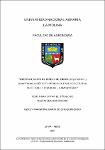Mostrar el registro sencillo del ítem
Identificación de líneas de arroz (Oryza sativa L.) adaptadas a déficit hídrico en fase vegetativa en el valle Chancay – Lambayeque
| dc.contributor.advisor | Heros Aguilar, Elizabeth Consuelo | |
| dc.contributor.author | Garrido Chuquipiondo, Gerly Marianne | |
| dc.date.accessioned | 2024-02-20T00:28:36Z | |
| dc.date.available | 2024-02-20T00:28:36Z | |
| dc.date.issued | 2024 | |
| dc.identifier.uri | https://hdl.handle.net/20.500.12996/6282 | |
| dc.description | Universidad Nacional Agraria La Molina. Facultad de Agronomía. Departamento Académico de Fitotecnia | es_PE |
| dc.description.abstract | El arroz, es uno de los alimentos más importantes para la canasta básica de los peruanos. Su producción demanda grandes cantidades de agua para obtener óptimos rendimientos. Por ese motivo, uno de los grandes desafíos de la producción de arroz, es ahorrar agua sin disminuir los rendimientos del cultivo. La alternativa presentada en este estudio, es identificar genotipos adaptados a condiciones de déficit hídrico que permitan un buen desarrollo al ser manejados con periodos de sequía con la técnica de riego "Alternate Wetting and Drying" (AWD). Esta investigación, se realizó en la Estación Experimental Vista Florida del Instituto Nacional de Innovación Agraria (INIA) de Lambayeque en la campaña agrícola 2019 - 2020. Se evaluaron dos tratamientos de manejo de riego: (1) Sistema de inundación permanente, (2) AWD con un periodo de déficit hídrico de 15 días en fase vegetativa y riego inundado el resto de las fases fenológicas en 17 genotipos. El objetivo principal, fue identificar a los genotipos con mayor adaptación a las condiciones de inundación y déficit hídrico, y analizar la influencia que tuvieron los dos ambientes sobre el rendimiento de grano y las características relacionadas al rendimiento. Como resultado se obtuvo, que el sistema de inundación permanente tuvo el rendimiento más alto (8.29 t. ha-1 ) a comparación del rendimiento alcanzado en déficit hídrico (5.64 t. ha-1 ). Los índices de selección de productividad media geométrica, productividad media, media armónica e índice de tolerancia al estrés, identificaron a los genotipos TP 30758 y TP 30598 como los más adaptados en los dos ambientes. | es_PE |
| dc.description.abstract | Rice is one of the most important foods for the basic basket of Peruvians. Its production demands large quantities of water to obtain optimal yields. For this reason, one of the great challenges of rice production is to save water without reducing crop yields. The alternative presented in this study is to identify genotypes adapted to water stress conditions that allow good development when managed with periods of drought with the "Alternate Wetting and Drying" (AWD) irrigation technique. This research was carried out at the Vista Florida Experimental Station of the National Institute of Agrarian Innovation (INIA) of Lambayeque in the 2019 - 2020 agricultural campaign. Two irrigation management treatments were evaluated: (1) Permanent flooding system, (2) AWD with a period of water stress of 15 days in the vegetative phase and flooded irrigation for the rest of the phenological phases in 17 genotypes. The main objective was to identify the genotypes with greater adaptation to flooding and water stress conditions, and analyze the influence that both environments had on grain yield and characteristics related to yield. As a result, it was obtained that the permanent flooding system had the highest yield (8.29 t. ha-1) compared to the yield achieved in water stress (5.64 t. ha-1). The selection indices of geometric mean productivity, mean productivity, harmonic mean and stress tolerance index identify the TP 30758 and TP 30598 genotypes as the most adapted in both environments. | es_PE |
| dc.format | application/pdf | es_PE |
| dc.language.iso | spa | es_PE |
| dc.publisher | Universidad Nacional Agraria La Molina | es_PE |
| dc.rights | info:eu-repo/semantics/openAccess | es_PE |
| dc.rights.uri | https://creativecommons.org/licenses/by-nc-nd/4.0/ | es_PE |
| dc.subject | Arroz | es_PE |
| dc.title | Identificación de líneas de arroz (Oryza sativa L.) adaptadas a déficit hídrico en fase vegetativa en el valle Chancay – Lambayeque | es_PE |
| dc.type | info:eu-repo/semantics/bachelorThesis | es_PE |
| thesis.degree.discipline | Agronomía | es_PE |
| thesis.degree.grantor | Universidad Nacional Agraria La Molina. Facultad de Agronomía | es_PE |
| thesis.degree.name | Ingeniero Agrónomo | es_PE |
| dc.subject.ocde | https://purl.org/pe-repo/ocde/ford#4.01.07 | es_PE |
| renati.author.dni | 70272954 | es_PE |
| dc.publisher.country | PE | es_PE |
| dc.type.version | info:eu-repo/semantics/publishedVersion | es_PE |
| renati.advisor.orcid | https://orcid.org/0000-0002-0179-3124 | es_PE |
| renati.advisor.dni | 08273091 | es_PE |
| renati.type | https://purl.org/pe-repo/renati/type#tesis | es_PE |
| renati.level | https://purl.org/pe-repo/renati/level#tituloProfesional | es_PE |
| renati.discipline | 811036 | es_PE |
| renati.juror | Blas Sevillano, Raúl Humberto | |
| renati.juror | Vega Ravello, Ruby Antonieta | |
| renati.juror | Huanuqueño Coca, Elías Hugo |
Ficheros en el ítem
Este ítem aparece en la(s) siguiente(s) colección(ones)
-
AGR-FT Tesis [280]





